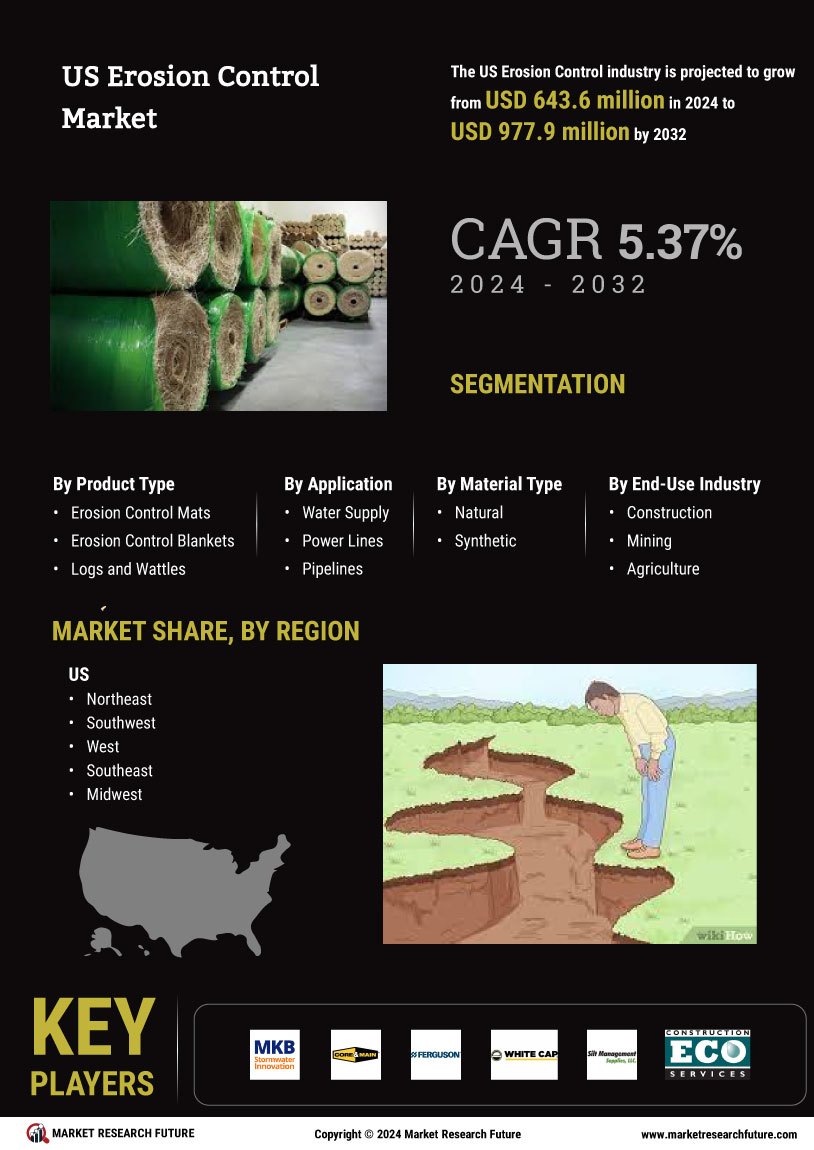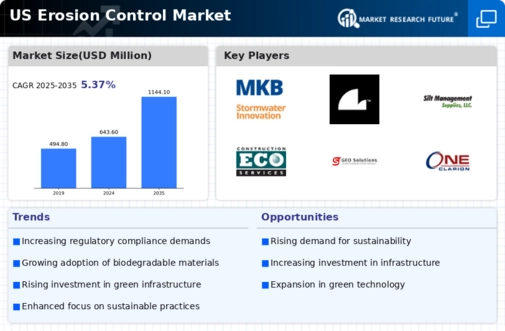RISING INFRASTRUCTURE DEVELOPMENT
Rising infrastructure development in US is playing a vital role in creating substantial need for erosion control. The country’s strategic focus on expanding and enhancing its infrastructure has led to substantial investments in numerous construction projects, which is further creating higher demand for erosion control products. The increasing population in the country is creating high need for housing, utilities, transportation, and various other infrastructure services which is further leading to increase in the infrastructural projects. Another crucial factor supporting the country’s infrastructural development is growing urbanization which is driving the need for new infrastructures.
Infrastructure development plays a very important role in supporting the economic growth of the country along with enhancing the quality of life of the population. But the construction and expansion of the infrastructures can have various environmental impacts and one such impact is soil erosion and thus erosion control measures are very essential for mitigating the environmental impacts along with ensuring the sustainability of the infrastructures.
Infrastructure development involves extensive earthworks, excavation and land clearing activities which can further disturb the natural landscape. The soil disturbance caused due to such activities increases the susceptibility of soil erosion and thus proper soil erosion measures are needed to be taken to prevent the sedimentation of water bodies, degradation of natural habits and loss of fertile topsoil. The earthworks required in the infrastructure projects can disrupt the natural drainage patterns, alter the soil structure, and can expose the soil to the erosion.
The soil erosion due to construction activities also changes the land levels further leading to water and wind erosion. Activities such as filling and grading reduce soil quality, lead to erosion, environmental degradation, and water pollution, further impacting both plants and animals.
Erosion by wind or water can result in the loss of topsoil and thus it is very important to prevent the soil erosion as the loss of this upper layer of soil can eliminates the soil’s natural ability to provide nutrients, regulate water flow, and combat pests and disease.
The installation of utility structures such as water pipelines and electrical cables involves activities that can significantly disturb the soil further exposing the soil to erosion and thus soil erosion control is of paramount Importance Soil erosion can cause the transport of sediments and pollutants into the water bodies, further affecting the water quality.
Also, soil erosion can impact the soil stability which can lead to slope failures, and landslides. Thus, the need for erosion control is rising which is expected to boost the market demand for erosion control products such as logs, erosion control mats & blankets, and wattles, among others.
INCREASING DEMAND FROM AGRICULTURE INDUSTRY
The agriculture industry is a very vital industry but the increasing advancements and expansion of agricultural practices with the intensifying land use has created the need for significant soil erosion control measures. This industry has undergone several transformations over the past few years and these transformations are the result of increasing population growth and their changing dietary preferences. With the significant rise in food demand, the agricultural sector is also expanding very rapidly.
There are several agricultural practices that leads to soil erosion and one such contributor is conventional tillage practices which involves the mechanical manipulation of soil through disking, ploughing, and harrowing for preparing seedbed, incorporating crop residues, and controlling weeds. This practice can disrupt the soil structure, further resulting in soil loss. Moreover, in monoculture cropping system, a single crop is grown on the same land repeatedly which can exacerbate the soil erosion by affecting the vegetative cover and leaving the soil vulnerable to the erosion.
Moreover, the land clearing done for agriculture purposes can substantially impact the vegetation cover, which is of significant importance for soil stabilization, reducing runoff and preventing the erosion. Furthermore, excessive irrigation without proper drainage infrastructure can result in waterlogging, salinization ad soil compaction, further increasing the risk of erosion.
The concern over soil erosion and its adverse impact on the agriculture sustainability is growing significantly and thus the demand for soil erosion control is accelerating. Soil erosion products plays a crucial role in limiting the detrimental effects of soil erosion. One of the effective ways of reducing soil erosion is by stabilizing the soil surfaces and thus the demand for products such as erosion control blankets and geotextiles is escalating as these products creates a physical barrier that protects the soil from the impacts of wind and water, which can dislodge the soil particles and cause soil erosion.
Also, these products offer the structural support to the soil surfaces that helps in preventing the washing away of soil due to heavy winds and rains. The use of erosion control mats is also increasing as it is effective in providing the immediate protection against the erosion that can occur due to rainfall or high winds. Also, these mats promote seed germination and water infiltration by reducing the runoff along with creating favourable environment for the growth of the plants.
Moreover, erosion control logs and wattles are placed along the contours or the vulnerable slopes in order to intercept runoff and slow down the velocity of the flow. By absorbing water and filtering the sediment, these products can efficiently limit the erosive impacts of runoff on the soil surfaces.
Geotextiles are used in the agricultural land for reinforcing the soil slopes and stabilizing the embankments by enhancing the stability of soil through distribution of the load forces. Silt socks are another type of soil erosion control product that finds significant application in controlling the soil erosion in agricultural sector by reducing runoff, promoting infiltration of water in the soil, and trapping the sediment particles, thus helps in reducing the soil erosion. Silt socks are easy to install and are flexible erosion control solution for agricultural applications.
Thus, using various types of erosion control products in the agricultural lands enables the farmers to implement effective erosion control measures and maintain long term viability of the agricultural landscapes.
In addition to the benefits offered by erosion control products and growing awareness regarding the impacts of soil erosion, the rising support from the government to prevent soil erosion is one of the significant factors favouring the market for erosion control products. The US Department of Agriculture (USDA) offers financial, educational, and technical assistance to the landowners for implementing conservation practices on privately owned land. With this help, farmers, ranchers, and forest landowners can implement measures for reducing soil erosion, enhancing water quality, and improving cropland, forestland, grazing lands, wetlands, and wildlife habitat.
The ongoing emphasis on sustainable land management practices is likely to drive innovations in erosion control technologies, reflecting a growing awareness of environmental stewardship among stakeholders.
U.S. Environmental Protection Agency














Leave a Comment